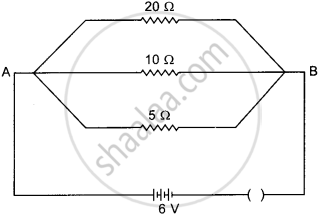Advertisements
Advertisements
प्रश्न
An electric lamp of 100 Ω, a toaster of resistance 50 Ω, and a water filter of resistance 500 Ω are connected in parallel to a 220 V source. What is the resistance of an electric iron connected to the same source that takes as much current as all three appliances, and what is the current through it?
उत्तर
Resistance of electric lamp, R1 = 100 Ω
Resistance of toaster, R2 = 50 Ω
Resistance of water filter, R3 = 500 Ω
Potential difference of the source, V = 220 V
These are connected in parallel, as shown in the following figure
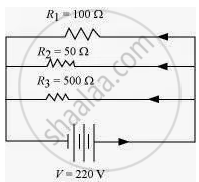
Let R be the equivalent resistance of the circuit.
The net resistance in parallel is given by
`1/R = 1/R_1 + 1/R_2 + 1/R_3`
Here, R1 = 100 Ω, R2 = 50 Ω and R3 = 500 Ω
`1/R = 1/100 + 1/50 + 1/500`
`= (5 + 10 + 1)/500`
= `16/500`
`R=500/16`
R = 31.25 Ω
Now, using Ohm’s law V = IR, we have
I = V/R
`=(220 V)/(31.25 Ω)`
= 7.04 A
Hence, the resistance of electric iron is 31.25 Ω and current through it is 7.04 A.
APPEARS IN
संबंधित प्रश्न
Differentiate between resistances in series and parallel.
Complete the following :-
(b)

Explain with diagram what is meant by the "series combination" and "parallel combination" of resistances. In which case the resultant resistance is : (i) less, and (ii) more, than either of the individual resistances?
A resistor has a resistance of 176 ohms. How many of these resistors should be connected in parallel so that their combination draws a current of 5 amperes from a 220 volt supply line?
In the circuit given below:
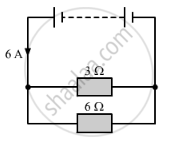
(a) What is the combined resistance?
(b) What is the p.d. across the combined resistor?
(c) What is the p.d. across the 3 Ω resistor?
(d) What is the current in the 3 Ω resistor?
(e) What is the current in the 6 Ω resistor?
Explain with the help of a labelled circuit diagram, how you will find the resistance of a combination of three resistors of resistances R1, R2 and R3 joined in parallel.
In the diagram shown below, the cell and the ammeter both have negligible resistance. The resistor are identical.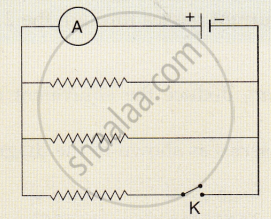
You are given three resistances of 1, 2 and 3 ohms. Shows by diagrams, how with the help of these resistances you can get:
(i) 6 Ω
(ii) `6/1` Ω
(iii) 1.5 Ω
How will you connect three resistors of 2 Ω, 3 Ω and 5 Ω respectively so as to obtain a resultant of 2.5 Ω? Draw the diagram to show the arrangement.
State how are the two resistors joined with a battery when equivalent resistance is less than either of the two resistances.
A combination consists of three resistors in series. Four similar sets are connected in parallel. If the resistance of each resistor is 2 ohm, find the resistance of the combination.
In the following figure calculate:
- the total resistance of the circuit
- the value of R, and
- the current flowing in R.
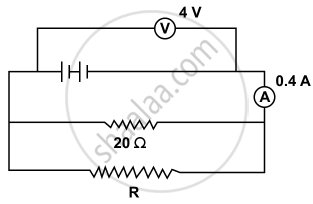
Explain, why is the p.d. between the terminals of a storage battery less when it is supplying current than when it is on open circuit. A battery of e.m.f. 10 volts and internal resistance 2.5 ohms has two resistances of 50 ohms each connected to it. Calculate the power dissipated in each resistance
(a) When they are in series,
(b) When they are in parallel.
In each case calculate the power dissipated in the battery.
An electrical appliance having a resistance of 200 Ω is operated at 200 V. Calculate the energy consumed by the appliance in 5 minutes in kWh.
Calculate equivalent resistance in the following cases:
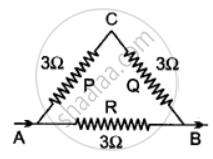
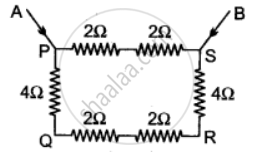
What connection is used in domestic appliances and why?
A piece of wire having a resistance R is cut into five equal parts.
- How will the resistance of each part of the wire change compared with the original resistance?
- If the five parts of the wire are placed in parallel, how will the resistance of the combination change?
- What will be ratio of the effective resistance in series connection to that of the parallel connection?
Calculate the current flows through the 10 Ω resistor in the following circuit.
